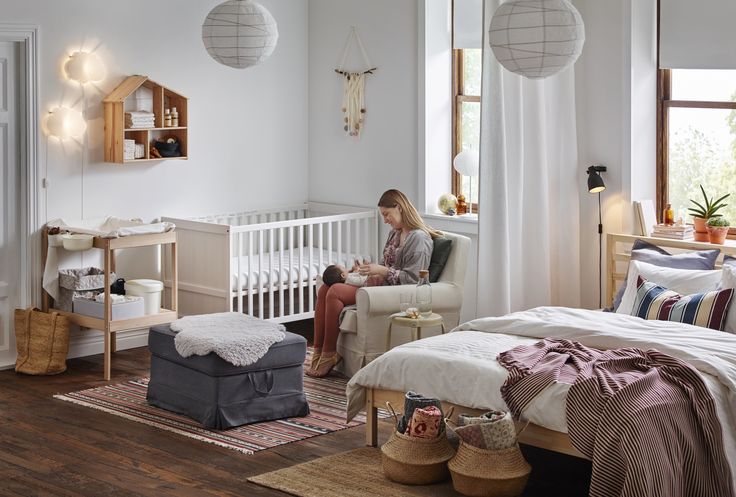
Making space feel right for everyone
There’s something beautiful — and sometimes a bit chaotic — about a shared room. Maybe you live in a one-bedroom apartment. Maybe your older child is already in the room, and now you’re expecting a baby. Whatever the setup, the idea of sharing space brings up one big question: where will the crib go?
You’d be surprised how many families make it work — and not just in a “well, we survived” way, but in a “this is actually working really well” kind of way. I’ve worked with parents who managed to fit a crib into walk-in closets, alcoves, even the corner of a sibling’s room — all while keeping a sense of peace and sleep intact.
When space is limited, intention matters more than square footage. It’s not about how big the room is — it’s how thoughtfully you arrange it.
With a few smart decisions and a realistic look at your needs, sharing a room can feel less like a compromise and more like a choice you’re proud of.
Safety stays first, always
One thing we don’t negotiate — even when every square inch counts — is safety. Your baby needs a sleep environment that’s free from soft bedding, has proper airflow, and meets crib safety standards. And when the crib shares space with another child, pet, or adult furniture, that’s an extra layer to consider.
I remember a client — two toddlers already sharing a room, expecting baby number three. They were considering squeezing a travel crib between a bookshelf and the wall. But once we measured and looked at airflow, we realized it just wasn’t safe. They ended up rearranging the entire room (yes, including moving the closet door!), but the final setup gave each child their own safe zone.
Room-sharing works when everyone has clearly defined space — even if it’s just a visual boundary.
Before you order anything, measure. Then measure again. And keep in mind that bassinets are only for the first few months. If you want a longer-term solution, look into mini-cribs or cribs that convert and grow with your baby.
When function beats size
A full-size crib isn’t your only option — especially not in a shared room. Mini-cribs, foldable cribs, or even crib-and-drawer hybrids can do wonders when space is tight. The trick is finding something compact that doesn’t skimp on what matters most: safety, comfort, and longevity.
One mom I worked with had twin boys in toddler beds and was due with her third. She chose a mini-crib on wheels with adjustable mattress height. Why? It fit snugly by the window, she could easily move it to vacuum, and it didn’t block access to anything else. Win-win-win.
A crib doesn’t need to be grand — it needs to be good. And good means practical, safe, and suited to your space.
If storage is a challenge, look for cribs with built-in drawers underneath. They’re great for stashing swaddles, sheets, and those hundred other tiny baby things that seem to multiply overnight.
Creating boundaries in shared spaces
Even if the room is shared, your baby still needs a space that’s clearly theirs. That doesn’t mean building walls — though room dividers or curtains can help — but it does mean thinking through sound, light, and activity levels.
One family I supported had a toddler and a newborn sharing a room. We hung a soft curtain between the toddler bed and the crib, added a white noise machine near the crib, and used a dimmable lamp on the toddler’s side. Both kids ended up sleeping better — not just the baby.
Clear boundaries help kids feel secure. Even in the same room, they can sense what’s theirs — and that matters.
Nighttime routines also help reinforce these boundaries. Try starting baby’s wind-down routine five minutes earlier than the older sibling’s — just enough time to set the tone and create a small buffer.
What worked for others might work for you
There’s no single “right way” to set up a shared room, but hearing what’s worked for others can spark ideas. I’ve seen families use portable cribs that double as playpens during the day, or wall-mount shelves to free up floor space. Some moved older kids to bunk beds and placed the crib under a loft nook. It’s about getting creative without sacrificing calm.
And yes, sometimes it takes trial and error. I had a couple who tried three different crib placements in the first month before landing on what worked. That’s okay. Your setup isn’t a one-time decision — it evolves as your child does.
Be gentle with yourself. Shared rooms are a dance — you learn the steps as you go.
The good news? Babies don’t care how designer your nursery is. They care that it feels safe, smells like home, and holds the people they love. If your crib setup gets you closer to that — even in a shared room — you’re doing just fine.
A space that fits more than furniture
At the end of the day, a shared room is just that — shared. And when it’s done thoughtfully, it becomes more than a space for sleeping. It becomes a room where siblings bond, where routines are built, and where a family’s rhythm gently unfolds.
So if you’re stressing over how to make a crib work in the room you already have, pause and breathe. You’re not alone. Many families make this work beautifully — not because they have the perfect setup, but because they care enough to try.
And that care? That’s what makes all the difference.


